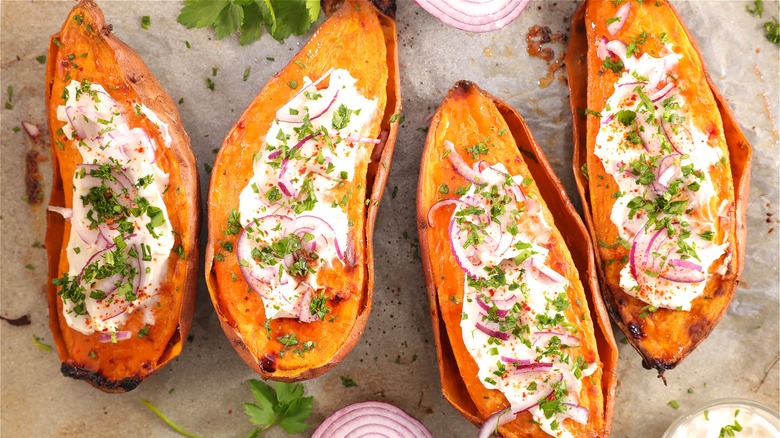The Symmetry Of Your Sweet Potato Can Really Make Or Break Your Dish
Choosing baked sweet potatoes as a side dish or main course accompaniment during the fall and winter months is sure to not only satisfy your taste buds, but also keep your belly nice and warm. However, if you're familiar with prepping raw sweet potatoes, you already know they come in a vast array of shapes and sizes.
Nothing is more frustrating than spending almost an hour baking a sheet pan full of these tuberous roots only to discover undercooked or watery spots. If you're planning to bake sweet potatoes with several of your favorite toppings, choosing the right shape of this nutritious vegetable is crucial. Strive for a symmetrical, uniform potato. Beyond having a desire for equally-sized halves, the main concern around uneven sweet potatoes has everything to do with over and undercooking parts of these foods. If you have a sweet potato that's long and thin on one end and fat and stubby on the other, you run the risk of one side overcooking or the other being left watery. However, the prospect of choosing only symmetrical sweet potatoes can be stifling, especially in the middle of a busy grocery store. If you can't always secure evenly-sized spuds, there are a few other ways to ensure sweet, thoroughly-cooked sweet potatoes every time.
You don't need symmetrical spuds for perfectly-roasted sweet potatoes
Not all sweet potatoes are blessed with perfectly-symmetrical shapes. To put your fears to rest, make sure you choose sweet potatoes with orange flesh. Unlike purple or tan sweet potatoes, those with orange and red flesh tend to be more moist because they contain higher amounts of the enzyme amylase, which is responsible for turning starch into sugar. Starch absorbs moisture, and because it's less present in orange sweet potatoes, you'll be left with a creamier result.
Next to choosing more moist varieties, you need to roast sweet potatoes until they're fully cooked on all sides. For those of you striving to learn how to bake sweet potatoes without any dry or watery spots, make sure you start with a super-hot oven and line a baking sheet with foil to catch any residual juice. Poke holes in your sweet potatoes for steam to escape, and if you desire, rub the outside skins with oil to prevent wrinkling of the skin. Instead of placing your prepped spuds directly on your baking sheet, you may want to add a baking rack to the interior and roast your sweet potatoes directly on the rack so heat can flow around all sides for even cooking. Cook these veggies for at least 40 minutes. Next to baking whole spuds, you might also be interested in trying some alternative cooking methods.
Alternative ways to make evenly cooked sweet potatoes
Although you can achieve perfectly-creamy spuds with variously-shaped sweet potatoes, if you have some flexibility around how your potatoes are served, you may want to try a few alternative cooking techniques. Take control over your sweet potato sizes by dicing up your spuds to make bite-sized oven-roasted sweet potatoes. Cutting sweet potatoes before roasting gives you more control over the final result. You can even keep a close eye on the roasting to stir and remove any cooked sweet potatoes that appear done before the suggested cooking time is complete. To achieve another variation of roasted deliciousness, make Hasselback potatoes, sweet potato-style, by upping the oven temperature to 425 degrees Fahrenheit. You will have a caramelized, creamy finish by taking an extra step to release some of that inner steam and allow the heat of the oven to fully penetrate the sweet potato flesh.
If you're not completely tied to roasted sweet potatoes, you can also dice sweet potatoes and boil them to make a delightful bowl of mashed sweet spuds. Alternatively, feel free to use your skillet with a bit of oil for pan-frying.


